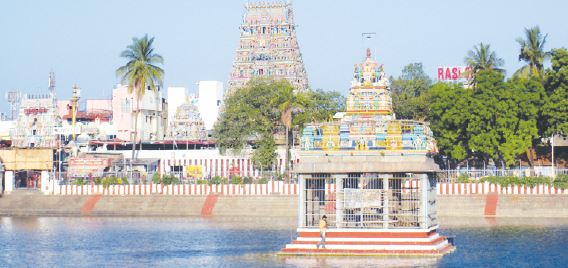(Anu Venugopal)
One of the sacred shrines in Tamil Nadu is Arulmigu Kapaleeshwarar Temple in Mylapore, in the hustle-puzzle Chennai City. Kapaleeswarar temple is one of the prominent Shiva temples in India situated in Mylapore. Here Lord Shiva is worshipped as Kapaleeswar (self-manifested] and Goddess Shakthi (Uma) as Karpagambal. There is a story behind how the place got the name Mylapore and the same story is the root of this magnificent pilgrim center. According to the legend, Goddess Karpagambal [Uma] wished to know the meaning of the five-lettered divine mantra “Na Ma Shi Va Ya”. She pleaded to Lord Shiva to teach her the true meaning of the mantra along with the significance of sacred ash. He agreed and once while he was teaching the same to Uma Devi, her eyes fall upon a beautiful peacock dancing, and lost her concentration. Lord Shiva displeased by her, cursed her to become a peacock. To free herself from the curse she was asked to go to Earth and do penance by worshipping him. Therefore Goddess Karpagambal worshipped the Shivalinga under the Punnai tree here where the temple stands.Pleased by her devotion, Lord Shiva freed the Goddess from the curse and she regained her original form. This is how the place came to be known as Mylapore [Mail – Peacock] where Goddess Karpagambal in her peacock form worshipped the Shivalinga and freed herself from the curse.Many tales prove the significance of the Kapaleeswarar Temple. Lord Muruga, son of Lord Shiva visited this temple and worshipped him and his mother Goddess Uma (Karpagambal) before heading to a war with an Asura [demon] named Surapadman, received the Shaktivel here at this temple, a divine powerful weapon his mother gave to fight the Asura.Now there is another fascinating legend of why Lord Shiva is known as Kapaleeshwarar. Once Lord Brahma, the creator as per Hindu mythology, considered him greater than Lord Shiva as he too had five heads and then Lord Shiva to teach Brahmma a lesson of humility, nipped one of the five heads of Brahma and held his skull in his hand, earning himself the name Kapaleeswarar for Kapalam in Sanskrit means Skull.The architecture of the temple is another great piece of Dravidian art. The temple authorities claim that the original temple was destroyed by the Portuguese. The current structure is more than 300 years old.There are two entrances to the temple, one on the east and the other on the west side of the temple with colorful Gopurams [temple tower] which enhance the beauty of the whole temple. The east Gopuram is 40m in height and is higher than the western Gopuram. There is a huge water tank in front of the western entrance which is another major landmark of the temple.The Shiva Lingam worshipped here is a Swayambhu Lingam, which means it is a self-manifested lingam. It is one of the 64 Swayambhu Lingams in the world. Other than the main deities Kapaleeswarar and Karpagambal, there are various other shrines of Natana Vinayakar, Palani Andavar, Vaayilar Nayanar, Singara Velar, Dakshinamurthy, Somaskandar, and Durgai. There is another small shrine outside, at the courtyard of the temple, and under the old Punnai tree depicting Goddess Uma in the form of a peacock worshipping Lord Shiva, which reminds us of the legend of how this place got its name “Mylapore”.I used to visit this temple very often when staying in Chennai. I used to be wonderstruck by the marvelous architecture. My grand-niece, an ardent devote visits the temple every Thursday to light a lamp to worship Dakshinamoory, a form of Lord Shiva who provided his devotees aspects of all sorts of knowledge and to embrace and feed the cows being taken care of in the temple.During the Margavi masa in December, the whole of Mylapore comes alive with beautiful kolams drawn on the road leading to the temple. There are Kolams displayed for contests also.



